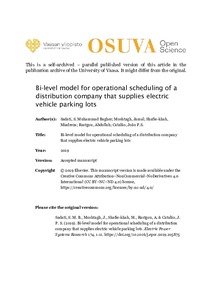Bi-level model for operational scheduling of a distribution company that supplies electric vehicle parking lots
Sadati, S. Muhammad Bagher; Moshtagh, Jamal; Shafie-khah, Miadreza; Rastgou, Abdollah; Catalão, João P.S. (2019-09-01)
Sadati, S. Muhammad Bagher
Moshtagh, Jamal
Shafie-khah, Miadreza
Rastgou, Abdollah
Catalão, João P.S.
Elsevier
01.09.2019
Julkaisun pysyvä osoite on
https://urn.fi/URN:NBN:fi-fe202102245862
https://urn.fi/URN:NBN:fi-fe202102245862
Kuvaus
vertaisarvioitu
© 2019 Elsevier. This manuscript version is made available under the Creative Commons Attribution–NonCommercial–NoDerivatives 4.0 International (CC BY–NC–ND 4.0) license, https://creativecommons.org/licenses/by-nc-nd/4.0/
© 2019 Elsevier. This manuscript version is made available under the Creative Commons Attribution–NonCommercial–NoDerivatives 4.0 International (CC BY–NC–ND 4.0) license, https://creativecommons.org/licenses/by-nc-nd/4.0/
Tiivistelmä
Nowadays, the presence of renewable energy resources (RERs), electric vehicle (EV) penetration, and the implementation of demand response (DR) programs are the main affecting factors in the operational scheduling of a distribution company (DISCO). By the new market participants such as parking lot (PL) owners in the DISCO, a bi-level framework can be created for modeling the distribution network. Therefore, in this paper, a new bi-level model is suggested for DISCO’s operational scheduling that involves technical and environmental terms in the objective function. The maximization of the profit of the DISCO owner and the PL owner are the objective functions in each level. These purposes depend on the customers’ load, the power purchased from the upstream network, the power exchanged with the PL owner (for the upper-level) and the power exchanged with the DISCO owner, as well as the EV owners (for the lower-level). Linearization of the model is carried out by applying the Karush–Kuhn–Tucker (KKT) condition and Fortuny-Amat and McCarl linearization approach. Furthermore, EVs’ and RERs’ uncertainties, as well as DR programs are modeled. Also, three types of risk are described including risk-seeker, risk-neutral, and risk-averse (with conditional value-at-risk (CVaR) index). For evaluation of the proposed model, it is applied to the IEEE 15-bus test system. Results show that by charging/discharging schedule of EVs and critical peak pricing program, the DISCO owner gains more profit. Also, the sensitivity analysis allows determining that the EV penetration, nominal power of RERs and customer involvement in the DR program directly affect the DISCO owner’s profit.
Kokoelmat
- Artikkelit [2621]
